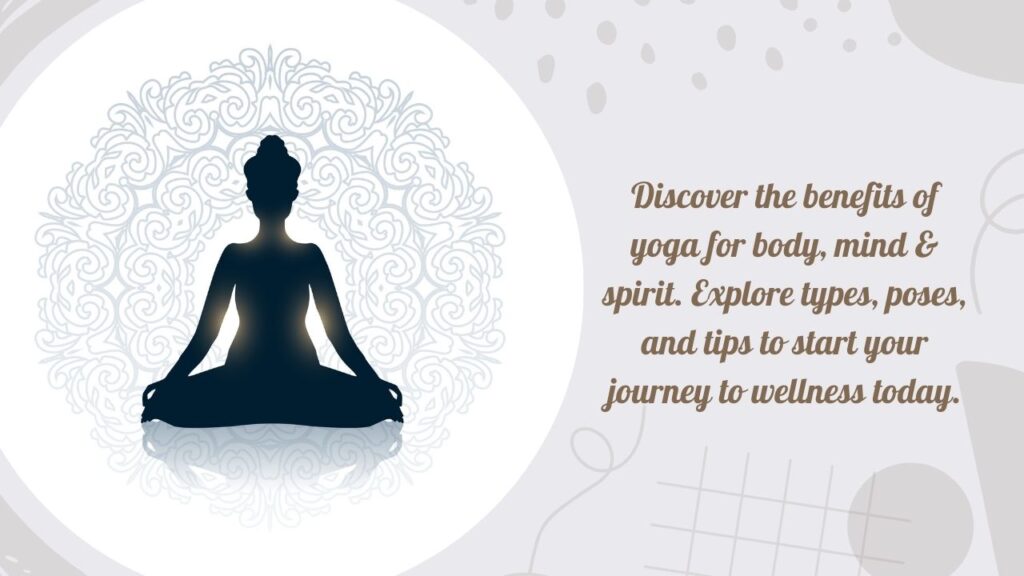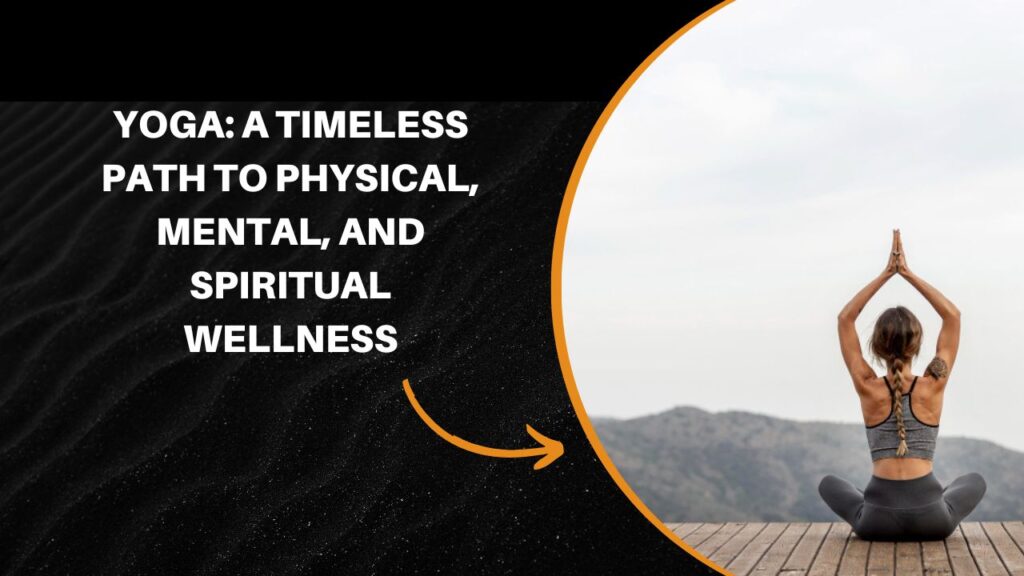In a world where stress, anxiety, and digital fatigue dominate daily life, a holistic practice offers a sanctuary. Far beyond just physical exercise, it nurtures the body, calms the mind, and uplifts the spirit. Whether you’re looking to improve your flexibility, reduce stress, or embark on a journey of self-discovery, this practice has something for everyone.
In this comprehensive guide, you’ll learn about the origins of yoga, its many forms, profound benefits, and how you can start your personal practice today.
This ancient discipline is known to science in India. It is a method designed to prepare the body and mind for the discovery of spiritual truths. As a science of life, it offers simple and affordable techniques to maintain both physical and mental well-being. It truly embodies the science of living.
Table of Contents
Yoga: A Holistic Path to Well-Being
This comprehensive practice nurtures the body, mind, and spirit. It blends physical postures, controlled breathing, and meditation to cultivate harmony between the mind and body. Practicing regularly can lead to improved flexibility, strength, balance, and reduced stress contributing to a greater sense of overall wellness.
- Improved Flexibility and Strength: Yoga poses (asanas) stretch the muscles and enhance strength, helping to increase your range of motion.
- Better Balance and Coordination: Specific poses help develop balance and coordination, which are essential for daily movement and injury prevention.
- Relief from Back Pain: Regular practice can alleviate back discomfort and support better posture.
- Emotional Stability: Yoga helps regulate emotions and may ease symptoms of anxiety and depression.
Spiritual Benefits of Yoga
- Increased Self-Awareness: Yoga encourages self-reflection and a deeper understanding of oneself.
- Cultivates Inner Peace: Breathing and meditation practices foster a sense of calm and inner tranquility.
- Supports Personal Growth: Yoga can be a journey of self-discovery, helping you find purpose and direction.
- Fosters Connection with Nature: The practice nurtures a sense of unity with the world around us, promoting environmental and spiritual awareness.
How Yoga is Practiced
- Asanas (Postures): These physical movements are designed to strengthen, stretch, and balance the body.
- Pranayama (Breathing Techniques): Controlled breathing methods, such as deep and alternate nostril breathing, help regulate the nervous system and boost energy.
- Meditation: Yoga includes various meditation practices to quiet the mind, reduce stress, and improve concentration.
- Yoga Philosophy: At its core, yoga is a philosophy centered on self-awareness, mindfulness, and unity with the universe.
What Is Yoga?
Although modern yoga is often associated with physical postures and stretches, its deeper roots lie in spiritual development, mental clarity, and inner peace.
Read more: Chair Yoga: A Gentle Path to Strength, Flexibility, and Stress Relief at Any Age
Read more: Yoga Nidra: The Ultimate Guide to Deep Rest and Inner Awakening
The History and Philosophy of Yoga
Yoga is believed to have originated over 5,000 years ago in ancient India. The earliest references to yoga are found in the Vedas, sacred Hindu scriptures. The philosophy was later codified by the sage Patanjali in the Yoga Sutras, where he introduced the concept of Ashtanga Yoga, or the “Eight Limbs of Yoga.” These include:
- Yama (moral discipline)
- Niyama (personal observances)
- Asana (physical postures)
- Pranayama (breath control)
- Pratyahara (withdrawal of senses)
- Dharana (concentration)
- Dhyana (meditation)
- Samadhi (absorption or enlightenment)
Understanding these principles helps deepen your practice and offers guidance on how to live a balanced, meaningful life.
| Section | Key Highlights |
| What Is Yoga? | Union of mind, body, and spirit; holistic practice beyond physical movement. |
| History & Philosophy | Originated in ancient India; based on Patanjali’s Yoga Sutras and 8-limb path. |
| Types of Yoga | Hatha, Vinyasa, Ashtanga, Kundalini, Iyengar, Bikram, Restorative, Yin. |
| Physical Benefits | Flexibility, strength, better posture, pain relief, balance, and coordination. |
| Mental & Emotional Benefits | Reduced stress and anxiety, improved focus, better mood, emotional clarity. |
| Spiritual Benefits | Enhances self-awareness, mindfulness, and emotional healing. |
| Yoga for All Lifestyles | Suitable for beginners, seniors, athletes, and pregnant women. |
| Core Elements | Yoga poses (asanas), breathing (pranayama), meditation, consistency. |
| Modern Yoga | Accessible via apps and online; growing global popularity; mindful of traditions. |
| Safety Tips | Listen to your body, use props, avoid overexertion, consult a doctor if needed. |
| Getting Started | Choose your style, set up a space, set goals, practice regularly and patiently. |
Not all practices are the same. Depending on your goals, personality, and fitness level, different types can meet your unique needs. Here are some of the most popular and widely practiced forms:
1. Hatha Yoga
Perfect for beginners, Hatha Yoga emphasizes basic poses and breathing techniques. It’s slow-paced and focuses on alignment and relaxation.
2. Vinyasa Yoga
Vinyasa is a dynamic, flowing style where poses are linked with breath. Often called “flow yoga,” it’s great for building strength and stamina.
3. Ashtanga Yoga
A more athletic and structured practice, Ashtanga Yoga follows a specific sequence of poses. It’s ideal for those who love consistency and discipline.
4. Kundalini Yoga
Focused on awakening your internal energy, Kundalini Yoga blends postures, breath work, chanting, and meditation. It’s a deeply spiritual form.
5. Iyengar Yoga
Using props like blocks and straps, Iyengar Yoga is precise and alignment-focused. It’s excellent for injury recovery or those with mobility limitations.
6. Bikram Yoga
Bikram Yoga is a set series of 26 poses performed in a heated room. This style helps detoxify and improve flexibility, though it’s not for the faint-hearted.
7. Restorative & Yin Yoga
These styles are slow and meditative, with long-held poses that encourage deep relaxation and fascia release. They’re perfect for stress relief.
The Incredible Benefits of Yoga
One of the biggest reasons people turn to yoga is because of its life-changing benefits—and the science backs it up.
Physical Benefits
- Improved flexibility and posture: Regular yoga practice stretches and tones the body, relieving stiffness.
- Increased strength and stamina: Certain yoga poses engage muscle groups that build functional strength.
- Pain relief: Yoga can reduce chronic back pain, arthritis discomfort, and joint issues.
- Better balance and coordination: Crucial for aging adults, yoga improves balance and helps prevent falls.
Mental and Emotional Benefits
- Reduces stress and anxiety: Breathwork and meditation stimulate the parasympathetic nervous system, calming the mind.
- Boosts mental clarity: Yoga encourages focus and mindfulness, increasing productivity and attention span.
- Improves mood: Regular practice elevates serotonin levels, reducing symptoms of depression.
Spiritual Growth
Yoga is also a powerful tool for self-awareness and emotional healing. Whether you’re connecting through meditation or a sense of community, it offers a sacred space to explore your inner self.
Whether you’re 16 or 60, an athlete or a couch potato, yoga adapts to your needs.
Yoga for Beginners
If you’re new to yoga, don’t worry. Start with yoga for beginners classes that introduce you to foundational poses like Downward Dog, Child’s Pose, and Mountain Pose. These will help build your confidence and body awareness.
Yoga for Seniors
Gentle forms like Hatha, Chair Yoga, or Restorative Yoga are perfect for seniors. They improve joint mobility, circulation, and emotional well-being without straining the body.
Yoga for Athletes
Yoga enhances performance in sports by increasing flexibility, improving focus, and aiding in muscle recovery.
Prenatal Yoga
Specialized prenatal yoga classes help expecting mothers manage physical discomfort, practice breathing for labor, and maintain emotional balance during pregnancy.
Essential Components of a Yoga Practice
To get the most from your yoga journey, include the following pillars:
Yoga Poses (Asanas)
Start with basic asanas like Warrior Pose, Tree Pose, and Cat-Cow. Over time, you can explore more advanced postures.
Breathing Techniques (Pranayama)
Control your breath to control your mind. Pranayama practices like Alternate Nostril Breathing or Ujjayi Breath reduce stress and boost lung function.
Meditation
Even five minutes a day can transform your mood and mental clarity. Use apps or guided meditations if you’re new.
Consistency
Like any lifestyle change, results come with regular practice. Start with 10–15 minutes daily and increase as you grow more comfortable.
Yoga is no longer confined to ashrams or studios. It’s in gyms, schools, hospitals, and all over YouTube. But with this explosion in popularity come a few modern realities:
- Online yoga classes make it easier than ever to practice from home.
- Social media influencers have popularized yoga, though sometimes focusing more on aesthetics than authenticity.
- Cultural appropriation debates remind us to practice with respect for yoga’s sacred roots in Indian tradition.
Still, its accessibility means more people are reaping its benefits than ever before.
Yoga Safety Tips and Precautions
While yoga is generally safe, it’s important to practice mindfully:
- Listen to your body: Don’t push into pain. Yoga is about progress, not perfection.
- Consult your doctor: Especially if you have existing health issues or injuries.
- Learn from qualified teachers: Proper guidance prevents injury and enhances your growth.

How to Start Practicing Yoga Today
Experiment with different types of yoga—online or in-person—until you find what resonates.
Step 2: Create a Space
Designate a quiet corner at home with a yoga mat, cushion, and maybe some calming music.
Step 3: Set Goals
Are you looking to gain strength, improve flexibility, or find inner peace? Knowing your “why” helps maintain motivation.
Step 4: Stay Consistent
Even 10 minutes a day can be powerful. Build a routine that fits into your lifestyle.
Conclusion: Yoga Is a Journey, not a Destination
This discipline isn’t just something you do—it becomes a way of life. It teaches patience, builds resilience, and opens your heart to the present moment. In today’s fast-paced world, the stillness you find on your mat could be your most powerful act of self-care.
Whether you’re drawn by the physical benefits or the promise of inner peace, it welcomes you as you are.
Start where you are. Use what you have. Breathe, stretch, grow.
Yoga is waiting for you—are you ready to step on the mat?
FAQ:
Q: What is yoga and why is it important?
Ans: Yoga is a holistic practice that connects the mind, body, and spirit through physical poses, breath control, and meditation. It’s important because it promotes flexibility, reduces stress, improves mental focus, and fosters emotional balance, making it a powerful tool for overall wellness.
Q: What are the main types of yoga for beginners?
Ans: The best types of yoga for beginners include Hatha Yoga for its gentle pace, Vinyasa Yoga for those who enjoy movement, and Restorative Yoga for relaxation. These styles offer a solid foundation and are easy to adapt as your practice grows.
Q: Can yoga help with stress and anxiety?
Ans: Yes, yoga is highly effective in managing stress and anxiety. Breathing exercises (pranayama), meditation, and mindful movement help activate the parasympathetic nervous system, reducing cortisol levels and promoting a calm, focused mind.
Q: Do I need to be flexible to start yoga?
Ans: Not at all. Yoga for beginners focuses on developing flexibility over time. You can use props and modifications to suit your current ability. Flexibility is a result of regular practice—not a requirement to begin.
Q: How often should I practice yoga to see results?
Ans: For noticeable benefits, aim to practice yoga at least 3–4 times per week. Even short daily sessions of 15–20 minutes can improve flexibility, reduce stress, and build strength over time.
Q: How does yoga help in physical, mental, and spiritual health?
Ans: Yoga enhances physical, mental, and spiritual well-being by increasing flexibility, strength, and balance; easing stress and anxiety; and cultivating inner peace and connection. It integrates physical postures (asanas), breathing practices (pranayama), and meditation to support overall holistic health.
Q: Is yoga a path to physical and mental wellbeing?
Ans: Yoga is a comprehensive practice that greatly enhances both physical and mental well-being. It boosts flexibility, strength, and balance, while also helping to reduce stress, sharpen focus, and foster inner peace. Through a blend of physical postures (asanas), breathing exercises (pranayama), and meditation, yoga supports overall health and mental clarity.
Q: How yoga provides both physical and mental health benefits?
Ans: 7 Benefits of Yoga
• Yoga enhances your strength, flexibility, and balance.
• It provides relief from back pain.
• Yoga can reduce symptoms of arthritis.
• It supports better heart health.
• Practicing yoga helps you relax and sleep more soundly.
• It can boost your energy levels and improve your mood.
• Yoga is an effective tool for managing stress.
Q: Is yoga a physical mental and spiritual discipline?
Ans: Yoke’ or ‘union’ refers to a set of physical, mental, and spiritual practices or disciplines that originated with its own philosophy in ancient India. These practices are intended to control the body and mind in order to achieve various forms of salvation, as observed in the Hindu, Jain, and Buddhist traditions.
Q: What is the real name of yoga?
Ans: The Sanskrit noun “yoga” originates from the root word “yuj” (युज्), which means “to join,” “attach,” “harness,” or “yoke.” According to Jones and Ryan, the term likely stems from this root because early yoga practice focused on controlling or “yoking” the senses.
Declaration Note:
We use third-party videos and images on https://yogavidhi.com/ for educational and illustrative purposes. All rights belong to their respective owners. No copyright infringement is intended.


